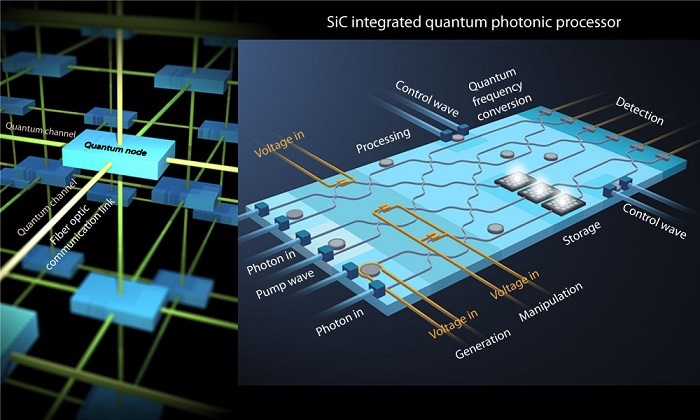August 8, 2016
Under a four-year, $2 million National Science Foundation (NSF) grant, Qiang Lin, assistant professor of electrical and computer engineering in the Hajim School of Engineering & Applied Sciences, will lead a photonics system integration research project to ultimately reduce the complexity and increase the capacity of quantum information processing for secure communication, metrology, sensing, and advanced computing.
Through integrated photonics, high-tech optical systems and high-tech electronics are joined together by transforming all needed optical components onto small chips.
“Our team will build chip-scale integrated silicon carbide quantum photonic processors for high-fidelity and energy-efficient quantum information processing, which interface seamlessly with fiber-optic links for secure communication and distribution of quantum information,” said Lin, principal investigator of the project and director of the University’s Laboratory for Quantum, Nonlinear and Mechanical Photonics, which studies the fundamental physics of light and its applications, including secure communication and advanced computing. Fiber optic links use powerful lights and extremely thin glass cables to transmit massive amounts data at very high speeds, often over long distances.
“We have a very strong, multidisciplinary, multi-university team of experts for this project, coming together in a shared vision,” said Lin.
Co-principal investigators are John Howell, professor of physics and optics, David Awschalom of the University of Chicago, Case Western Reserve University’s Philip Feng, and MIT’s Jurgen Michel—all global experts in chip-scale integrated SiC quantum photonic processors. Members of the National Institute of Standards and Technology (NIST), Thomas Gerrits, Sae Woo Nam, and Richard Mirin, are also collaborating on this project.
The research is expected to result in a new class of device technologies with previously inaccessible attributes and merits that may eventually have profound commercial impact on the industrial sectors. SiC combines excellent linear optical, nonlinear optical, point defect, electrical, mechanical, and thermal characteristics into a single material with mature wafer processing and device fabrication capability, thus representing a promising material system for integrated quantum photonics.
Research such as this also feeds into the work of the AIM Photonics (American Institute for Manufacturing Photonics) consortium of the U.S. Department of Defense, of which the University of Rochester is a partner.
Project findings are also intended to generate extraordinary educational materials and inspiration for students from K-12 to graduate students.
Visit the NSF website for more on this project, titled EFRI ACQUIRE: A Scalable Integrated Quantum Photonic Interconnect. Funding comes from NSF’s Emerging Frontiers in Research and Innovation (EFRI), the signature program for the Office of Emerging Frontiers and Multidisciplinary Activities (EFMA) within the Directorate of Engineering.













